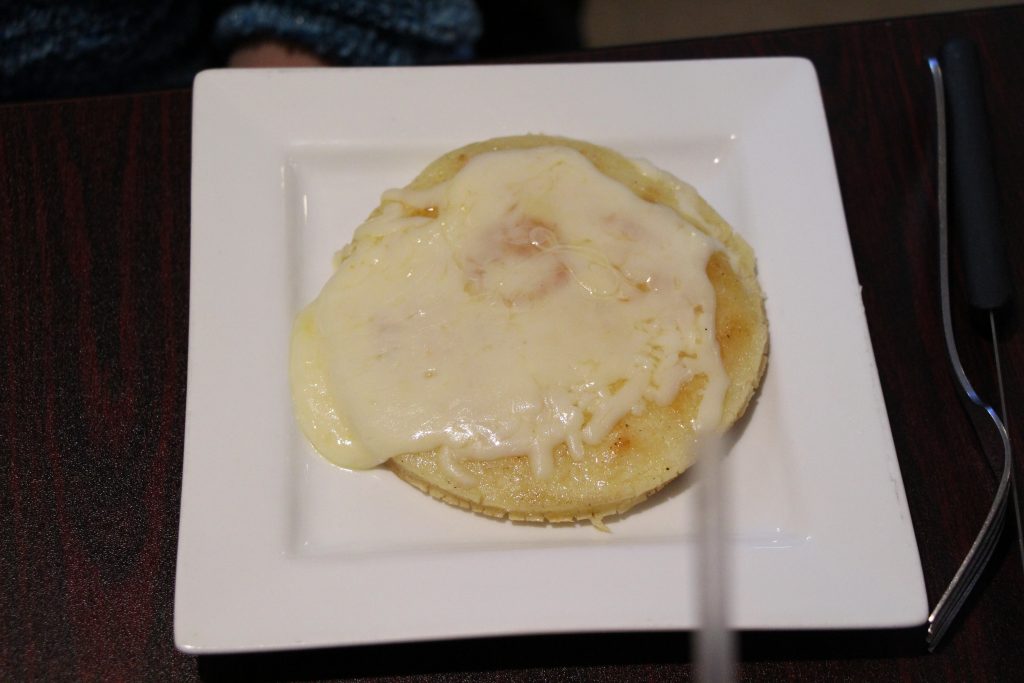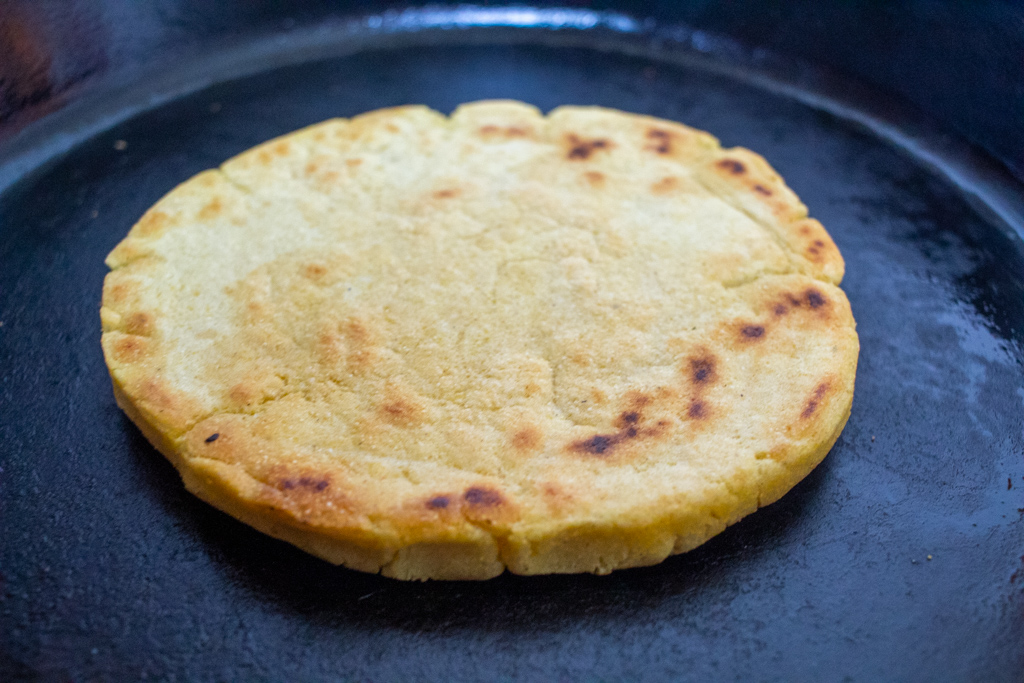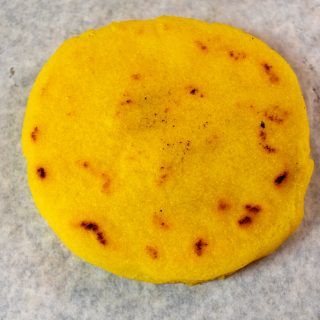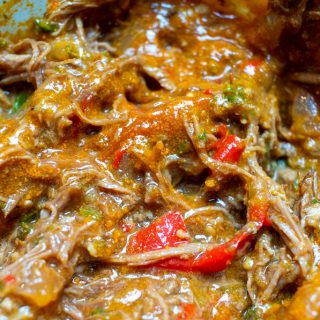Arepas, a Venezuelan, (Pre-)Colombian Snack
I could have eaten arepas all month.
I have, in fact, been eating arepas all month. I’ve been eating them for years, preparing for this post. The thing is, though–eating something does not grant you any specific insight into it, or the culture that produced it. Eating something does not equate to writing a couple thousand words about that subject. Eating arepas is fun, sure, but it’s not the work. Learning arepas, writing about them, that’s the work.
Arepas are an important part of both the Colombian and Venezuelan diets, and both countries claim to be the originators of these thick corn pancakes. But the Carib people north of South America’s Amazon rainforest, spread across modern-day Venezuela and Colombia, Guyana, Suriname, parts of Northern Brazil–they were making arepas centuries before today’s maps were drawn and borders claimed, cooking maize and drying it, pounding it into a fine powder and forming it into flattened cakes to be baked on clay griddles called budare, and the name arepa itself derives from the Carib term for corn, erepa.
As far as I can tell, history does not record how these primordial arepas were eaten. Were they swiped blisteringly hot from the griddle with nimble yet calloused fingers and consumed while still steaming, crisp-crusted yet soft inside? Were they wrapped in a leaf and brought along the day’s business, to be eaten at midday or bite by bite throughout the afternoon? Were they used like edible spoons, scooping cooked squash or beans or a fish stew from a communal vessel?
Whatever the original arepas may have been and however they were eaten, today they are–generally speaking–served in ways that differ slightly between Colombian and Venezuelan cuisine. The Colombian arepas are usually served simply, with a little butter or cheese, and often eaten as a starchy side for a meat dish, in the manner an American biscuit is, perhaps. Mekato’s Colombian Bakery in Chicago serves small arepas in this style alongside their chorizo and chicharrones.


ArePA George, a Colombian restaurant in Chicago, serves a simple arepa with melted cheese on top

However, they also serve a variety of stuffed arepas, including versions with Colombian chorizo and shredded chicken, both covered in a blanket of melted white cheese.


Another street food common at least to the Colombian city of Cartagena (and thanks go to my friend the intrepid food adventurer Titus Ruscitti for bringing this to my attention) is the arepa de huevo. A deep-fried arepa is cut open, filled with a raw egg and perhaps some seasoned ground beef, then resealed with reserved arepa batter and fried again for a short time to cook the egg. According to the recipes I read, the arepa dough, though unleavened, should bubble out leaving an empty cavity in the middle much the way bokits or Trini bakes do, if the masarepa batter is made properly wet and fried at the right temperature. However, I experimented with different hydration levels and frying temperatures and was never able to get that bubble to form, which made the resulting arepas extremely difficult if not impossible to reseal and deep-fry again. I finished these in the oven instead and they were delicious but I do hope to try the real thing someday.



Venezuelan arepas, on the other hand, tend toward the filled variety, first baked, then slit open and stuffed with a variety of ingredients–black beans, sweet fried plantains, various meats and cheeses and vegetables.






Rica Arepa in Chicago, which we visited in 2021 while writing about Venezuelan Patacones and again more recently, specializes in arepas, with multiple menu pages devoted to the various flavors they offer. I have not yet been able to try them all. However, several are pictured above–Pabellon, combining sweet fried plantains with queso fresco, black beans, and shredded beef; Punta Trasera & Queso Mano, with grilled strips of sirloin steak, an avocado salsa called guasacaca, and a type of mild stretchy cheese similar to fresh mozzarella; and Sifrina, which combines a Venezuelan chicken and avocado salad called Reina Pepiada with shredded Gouda cheese.
Once again, with Venezuelan-style arepas, it took some trial and error for me to arrive at the correct ratios for the batter. Some recipes call for a dryer mix, and some are much more fully hydrated. Many descriptions say that the masa, salt, and water are all that’s needed, yet most of the recipes I’ve seen add some fat as well. My first attempts combined yellow masarepa, made from corn that is first cooked and then dried and powdered, with a whiter nixtamalized masa harina. In addition to simply being too dry, this version did not turn out correctly–the softer masarepa is the correct flour for arepas and the type of masa used for tamales or tortillas is not the same.

So I switched to full masarepa at a higher level of hydration and though these arepas appear much yellower than what I had at Rica Arepa (the yellow masarepa is what I was able to source), they were much closer in flavor and texture.
Here’s the ratio I settled on–I cannot say that this is a 100% authentic recipe but it’s what worked for me.
Arepas
Ingredients
- 1 cup masarepa
- 1 cup water
- 1 tbsp shortening melted
- 1 tsp kosher salt
Instructions
- Combine all ingredients in a bowl, mix roughly and let sit for 5 minutes to allow the masarepa to absorb the water
- Separate into 2 equal-sized balls. With each ball, place onto a sheet of wax paper, smash into a rough circle with the ball of your hand. Pressing down with one hand and rotating, work the dough into a rough circle about 1/2 inch thick, using the other hand to smooth cracks in the sides and make them even.
- Cook for 5-6 minutes per side in a lightly-oiled pan over medium heat.
- Split open and stuff with your preferred filling.
A Venezuelan arepa might have as simple a filling as a couple slices of ham and some shredded cheese, returned to a griddle or to the oven just long enough to melt the cheese.

Black beans and white cheese–queso fresco here, though different styles of cheese may be used–is a common arepa filling combination called “Domino” in Venezuela due to the contrasting black and white colors.

I also made my own version of Reina Pepiada to try in an arepa without the shredded Gouda. Reina Pepiada translates as “curvy queen” and was named after Susana Duijm, named “Miss Venezuela” in the 1950s and the first Venezuelan contestant to go on to become “Miss World.” As an homage, the proprietors of an arepera in Caracas known for inventive arepa recipes designed this chicken salad arepa filling, combining shredded chicken with mashed avocado, lime juice, minced onion and red pepper and cilantro


My favorite of the fillings though was Carne Mechada, a seasoned shredded beef similar to what I had been served previously at
Carne Mechada
Equipment
- 1 Pressure Cooker
Ingredients
- 1.5 kg skirt steak
- salt and pepper
- 2 tbsp oil
- 1 large onion diced
- 1 red bell pepper diced
- 5 cloves garlic minced
- 2 tomatoes diced
- 1 tsp cumin
- 1 tbsp Worcestershire sauce
- 2 tbsp tomato paste
- 6-8 cups beef stock
- 1/2 bunch cilantro large stems removed, finely chopped
- 1/4 bunch parsley large stems removed, finely chopped
Instructions
- Heat oil in the pressure cooker on saute setting
- Cut the skirt steak into pieces small enough to fit in the pressure cooker and season on one side with salt and pepper.
- Brown each piece of skirt steak and set aside.
- Once all the meat has been browned, cook the onions and peppers in the instant pot, using the liquid they express to scrape up the bits of beef fond from browning the meat
- Add the garlic toward the end of cooking the onions
- Add the cumin, diced tomatoes, and Worcestershire sauce and cook for a few more minutes
- Add the tomato paste and stir into the onions. Add about a cup of the beef stock and stir to combine.
- Return the steak along with any juices that have collected underneath it to the pot. Pour in enough beef stock to cover.
- Pressure cook on the Meat setting for 45 minutes then allow the steam to dissipate
- Using a spider (the meat will be very tender at this point and will fall apart if you grab it with tongs), remove the meat to a bowl to be shredded. Leaving the pressure cooker unlidded but with the heat on, allow the liquid to reduce while shredding the beef.
- Shred the beef using two forks
- Return the shredded beef to to the cooking liquid. Add the parsley and cilantro and stir to combine. Allow to come up to temperature and then serve
In the Rica Arepa version pictured above, they serve this as part of an arepa named after the Venezuelan dish Pabellon Criollo. Pabellon Criollo is a plate composed of white rice, black eans, and this shreddded beef, usually with either fried plantains or a fried egg. However, another popular combination is beef or another meat with guasacaca, a Venezuelan avocado salsa similar to guacamole but smoother, less spicy, with a vibrant presence of lime juice and fresh herbs.


Of the many arepas I ate this month, this was my favorite. The savory nature of the beef is enhanced by the addition of multiple forms of tomato as well as the beef stock, with the sweetness of the cooked onion and red pepper never far from the tongue. But the acidity and bright cilantro-forwardness of the guasacaca cuts through this wall of umami, bringing with it the creamy fattiness of the avocado. The tangled matrix of beef strands carries with it a juiciness that does tend to overwhelm the bottom layer of arepa but these are not tidy sandwiches to begin with. I’ll take delicious any day, even if it requires a knife and fork.
I wonder if I can get Rica Arepa to serve me one this way

I like sandwiches.
I like a lot of other things too but sandwiches are pretty great













Missing a key instruction once you’ve mixed all the ingredients you should let the dough sit at least 15 minutes for the dough to hydrate.